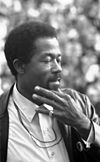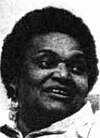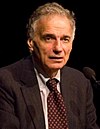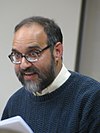| Revision as of 22:19, 11 July 2023 edit2600:6c88:7000:1b:a955:8b1e:c29f:42c (talk) →Gubernatorial elections← Previous edit | Revision as of 08:40, 9 September 2023 edit undoKingofthedead (talk | contribs)Autopatrolled, Extended confirmed users, Pending changes reviewers, Rollbackers53,420 edits →Presidential ticketsNext edit → | ||
| Line 181: | Line 181: | ||
| |- | |- | ||
| |] | |] | ||
| |]<br />''']''' | |]<br />''']''' | ||
| |{{flag|Pennsylvania}} | |{{flag|Pennsylvania}} | ||
| |{{small|] activist<br />Prison inmate}} | |{{small|] activist<br />Prison inmate}} | ||
Revision as of 08:40, 9 September 2023
American left-wing political party| Peace and Freedom Party | |
|---|---|
 | |
| Leader | Central Committee |
| Founded | June 23, 1967; 57 years ago (1967-06-23) |
| Ideology | Eco-socialism Feminism Pro-peace politics Socialism |
| Political position | Left-wing |
| Colors | Green |
| Website | |
| peaceandfreedom | |
The Peace and Freedom Party (PFP) is a left-wing political party with affiliates and former members in more than a dozen American states, including California, Colorado, Florida, Hawaii, Indiana and Utah, but none now have ballot status besides California. Its first candidates appeared on the 1966 New York ballot. The Peace and Freedom Party of California was organized in early 1967, gathering over 103,000 registrants which qualified its ballot status in January 1968 under the California Secretary of State Report of Registration.
The party has appeared in other states as an antiwar and pro-civil rights organization opposed to the Vietnam War and supporting black liberation, farm-worker organizing, women's liberation, and the gay rights movement. Its presidential candidates were Leonard Peltier in 2004, Ralph Nader in 2008, Roseanne Barr in 2012 and Gloria La Riva in 2016 and 2020.
Platform
According to its website, the party "is committed to feminism, socialism, democracy, ecology, and racial equality", advocating "to build a mass-based socialist party throughout the country". It is a strong advocate of environmentalism, aboriginal rights, rights to sexuality, government-funded health care, a woman's right to an abortion, public education, subsidized housing, and a socialist-run economy.
History
Founding
The Peace and Freedom Party grew out of the civil rights and anti-war movements on June 23, 1967. The major factors behind the new party were unhappiness with the Democratic Party's support for the war in Vietnam and also a perception that the Democrats were failing to effectively support the civil rights movement.
In the 1966 House of Representatives elections, three people ran under the Peace and Freedom Party banner. Herbert Aptheker received 3,562 votes in New York state's 12th Congressional District; Robert B. Shaw received 1,974 votes in Washington state's 7th Congressional District, and Frank Patterson received 1,105 votes in Washington state's 2nd Congressional District. Late 1966 began a number of voter registration drives in various states with the intent to build a national party. Most notably in the San Francisco Bay Area and in Los Angeles county, activists became deputy registrars of voters as peace organizers, anti-war veterans and civil rights workers.
Election of 1968
The party achieved ballot status in California in January 1968 by registering over 105,000 voters under its banner. It later got ballot status in 13 other states, but in all of those, the election laws and small organization meant that most were unable to retain ballot status after 1968.
The PFP's first national convention to nominate candidates for president and vice president was held in Ann Arbor, Michigan on August 17 – August 18, 1968. Ric Hyland, as California PFP's National Administrator, was convention chair. Eldridge Cleaver was nominated for president over Richard C. "Dick" Gregory by a margin of 161.5 to 54. Cleaver, a convicted felon and Black Panther spokesman, was technically not eligible to run since he would not yet be 35 by the time of the inauguration in January 1969. Due to the needs of the state parties to collect signatures, the party fielded several vice presidential nominees, including Chicago activist Peggy Terry, activist Rodolfo "Corky" Gonzales, radical economist Doug Dowd and Judith Mage, who had been nominated at the national convention. Cleaver personally preferred Yippie leader Jerry Rubin. Gregory also appeared on the ballot in several states along with his vice presidential running mate Mark Lane as the Peace and Freedom Party candidate as well as in New York as the candidate of the Freedom and Peace Party. Two states (California and Utah) refused to list Cleaver on the ballot, although each state listed the presidential electors and candidates for vice president (Peggy Terry in California and Corky Gonzales in Utah).
A variety of people joined the party in its first election. Bob Avakian was a spokesman for the party in the San Francisco Area and from the north coast where artists and activists such as Emmy Lou Packard and Byron Randall were involved. New York's Peace and Freedom Party consisted of a fractious coalition of competing Marxist groups, along with libertarians led by economist Murray Rothbard. Libertarians and some anarchists briefly competed for the leadership in the California party by running against the Socialist Campaign Collective and the Unity Coalition. The convention was deadlocked when the libertarians and about a third of the Unity Coalition walked out and formed a rump convention, leaving the socialists and their feminists allies with a clear majority. Most of the Libertarians left following the walkout at the 1974 convention. At that event, the California Secretary of State ruled that the group of people who had voted to make the party feminist and socialist would be considered the official party in California since they were the ones who had remained in the convention room.
In the election of 1968, the party fared fairly well for a newly ballot qualified party. Nationally, Gregory outpolled Cleaver, receiving 47,097 votes to Cleaver's 36,623 because some states had disqualified Cleaver because of his age. In California and Utah, where no presidential nominee appeared on the ballot, the voters cast 27,887 votes for the party presidential race where the vice presidential were on the ballot. The full nationwide vote for presidential electors was 111,607. Party candidates for the Senate received a national total of 105,411 votes. In Utah, the party fielded folk singer Bruce "U Utah" Phillips for Congress who trailed with 2,019 votes. The party retained ballot status in California in the 1970 general election, which it retained for a number of years except for 1999 to 2003. In 2003, Peace and Freedom Party became the first party in the history of California to regain its ballot status.
In 1968, the party held a statewide founding convention in Richmond, California. San Francisco chair Ric Hyland, co-founder of the Radical Caucus, nominated Eldridge Cleaver for presidential candidate. Cleaver beat out Dick Gregory and Dr. Ben Spock on the basis of the slogan: We are not seeking the candidate with the broadest appeal, we seek the candidate with the deepest truth. Radical journalists Paul Jacobs and Robert Scheer were selected as the party's candidates for the U.S. Senate.
In 1970, Marge Buckley received 177,716 or 2.8% of the vote for Attorney General of California and C. T. Weber had 149,961 recorded votes (2.4%) in the vote for State Controller. By getting over 2 percent of the statewide vote, each of these candidates insured the party would maintain on the ballot through the 1974 election.
People's Party
After 1968, the party affiliates in most states dissolved primarily because of ballot access restrictions in many states. However, the California party continued to maintain enough registered voters to hold on to its ballot status and in some partisan districts the party held the balance of power between the so-called major parties.
Throughout the 1970s and into the 1980s, the California party continued to contest local elections and sometimes win city and service district elections, most notably in Sonoma County, where it won three of the five member Cotati city seats council. Another milestone was reached when Kayren Hudiburgh of San Francisco was elected state chair in 1974 of the California party, the first woman to hold this position in any of the ballot qualified parties in the state. Hudiburgh also ran twice for the state assembly in this time period.
The California party became part of the coalition making up the national left-wing People's Party. For 1972, the People's Party nominated the feminist and democratic socialist, the noted anti-war activist Benjamin Spock for president along with Julius Hobson of the D.C. Statehood Party for vice president. In 1976, the party nominated Margaret Wright as its first woman contender for president. Wright lived in the Watts section of Los Angeles and had worked closely with the Black Panther Party. Wright was also noted as being the founder of Women Against Racism.
Recent history
In 1998, the Peace and Freedom Party of California failed to attain more than the required two percent of the votes cast for one of its statewide candidates and was removed from the ballot as a ballot qualified party. In 2003, after a voter registration drive Peace and Freedom Party became the first ballot qualified party in California history to lose its ballot status for more than one election and then requalify for the ballot. Longtime Peace and Freedom Party activist C. T. Weber was one of 135 candidates who ran for governor in the October 2003 recall election. In this recall, voters removed then-Governor Gray Davis (a Democrat) and elected Republican Arnold Schwarzenegger. At its August 2004 state convention, the Native American activist Leonard Peltier was nominated as Peace and Freedom Party's presidential candidate. Peltier was at the time (and still is) imprisoned serving a life term for the 1975 murders of two FBI agents; the Party considers him to be a political prisoner. Party members who supported Peltier's candidacy hoped to draw attention to his case and to the effort to win a presidential pardon for Peltier.
The party again fell under the required number of registered voters to retain ballot status in February 2006 and was declared disqualified by the California Secretary of State. However, citing previous instances in which parties not meeting the ballot qualification criteria were still allowed to participate in primary elections and the fact that there had not yet been a regular gubernatorial election since the party regained its ballot status (and as such, the decision was premature), the decision to bar the party from the June 2006 Primary was reversed after less than a week.
In the 2006 California elections, two statewide Peace and Freedom Party candidates received more than the required vote, thus ensuring the party's ballot status for another four years (Elizabeth Cervantes Barron received 212,383 votes, 2.5% of the total, for Controller; and Tom Condit received 187,618 votes, 2.2% of the total, for Insurance Commissioner)-
On the March 30, 2008, the State Central Committee endorsed a plan to create a National Organizing Committee (NOC) and a national political party. The NOC was instructed to work toward a national "multi-tendency non-sectarian organization committed to socialism, democracy, feminism, environmentalism and racial equality". A national organizing conference was set for December 2008 following the general election.
A political convention was held August 2–3, 2008 in Sacramento to select the party's 2008 presidential ticket. Contending for the nomination were Gloria La Riva (also nominee of the Party for Socialism and Liberation), Cynthia McKinney (also nominee of the Green Party) Brian Moore (also nominee of the Socialist Party), and independent presidential candidate Ralph Nader, who won. The results were the following: Nader (46%), Gloria La Riva (27%), Brian Moore (10%) and Cynthia McKinney (6%). Nader's running mate, former San Francisco Supervisor Matt Gonzalez, was endorsed for vice president by acclamation. The nomination ensured that the Nader/Gonzalez presidential ticket would appear on the ballot in California for the 2008 election.
On August 6, the Nader/Gonzalez campaign submitted sufficient signatures to appear on the Iowa and Utah ballots as the Peace and Freedom Party candidate. This was the first expansion of the party beyond California since the 1970s. However, the party did not achieve the votes necessary to guarantee ballot access in Iowa and Utah in subsequent elections.
Since 1968, over 400 different candidates have sought Peace and Freedom Party nominations for public office.
In 2016, the party's California state chair wrote the California Secretary of State, asking for Jill Stein to be placed on the party's ballot. Stein wrote as well. She was kept off the party's California primary ballot by the Secretary of State. The Peace and Freedom's 2016 presidential candidate Gloria La Riva was also the nominee of the Party for Socialism and Liberation.
California's 2018 gubernatorial primary had statewide office candidates registered in the party. In the race for Insurance Commissioner, Peace and Freedom candidate Nathalie Hrizi received 316,149 votes, 5.0% of total.
In 2019, the Peace and Freedom Party in California grew from 76,784 registered voters in February to 90,121 in October. This growth of 17.4% was the highest growth rate achieved by any California political party. On more recent registration statistic reports, the party has had only increments of registrations, up to 105,535 registrations as of February 10, 2021.
Election results
Presidential tickets
| Year | Presidential nominee | Home state | Previous positions | Vice presidential nominee | Home state | Previous positions | Votes California | Votes
nationwide |
Notes |
|---|---|---|---|---|---|---|---|---|---|
| 1968 |  Eldridge Cleaver |
Civil rights activist Black Panther Party leader |
Peggy Terry | Civil rights activist | 27,707
(0.38%) |
36,571 (0.05%) 0 EV |
|||
| 1972 |  Benjamin Spock |
Physician, author | Julius Hobson | Member of the District of Columbia Board of Education (1968–1969) Candidate for District of Columbia's at-large congressional district (1971) |
55,167
(0.66%) |
78,759 (0.10%) 0 EV |
|||
| 1976 |  Margaret Wright |
Activist |  Benjamin Spock |
Nominee for President of the United States (1972) |
41,731
(0.53%) |
49,016 (0.06%) 0 EV |
|||
| 1980 | Maureen Smith | Chair of the Peace and Freedom Party (1978–1980) |
Elizabeth Cervantes Barron | Nominee for California's 13th congressional district (1974) Nominee for California State Controller (1978) |
18,116
(0.21%) |
18,116 (0.02%) 0 EV |
|||
| 1984 |  Sonia Johnson |
Feminist activist, writer | Emma Wong Mar | Chair of the Peace and Freedom Party (1982–1984) Nominee for California's 12th State Assembly district (1982) |
26,297
(0.28%) |
72,161 (0.08%) 0 EV |
|||
| 1988 | Herbert G. Lewin | Candidate for Governor of Pennsylvania (1950) Candidate for United States Senator from Pennsylvania (1956) |
Vikki Murdock | Nominee for California's 54th State Assembly district (1986) |
58
(0.00%) |
10,367 (0.01%) 0 EV |
|||
| 1992 | Ronald Daniels | Former Executive Director of the Center for Constitutional Rights Former Executive Director of the National Rainbow Coalition |
Asiba Tupahache | Activist | 18,597
(0.21%) |
27,961 (0.03%) 0 EV |
|||
| 1996 | Marsha Feinland | Nominee for California's 14th State Assembly district (1990, 1992) |
Kate McClatchy | Nominee for California's 42nd congressional district (1986) |
25,332
(0.25%) |
25,332 (0.03%) 0 EV |
|||
| 2004 |  Leonard Peltier |
American Indian Movement activist Prison inmate |
Janice Jordan | American Indian Movement activist | 27,607
(0.22%) |
27,607 (0.02%) 0 EV |
|||
| 2008 |  Ralph Nader (campaign) |
Lawyer, activist Candidate for President of the United States (1996, 2000, 2004) |
 Matt Gonzalez |
Member of the San Francisco Board of Supervisors (2001–2005) |
108,381
(0.80%) |
739,278 (0.56%) 0 EV |
|||
| 2012 |  Roseanne Barr |
Actress and comedian |  Cindy Sheehan |
Anti-war activist | 53,824
(0.41%) |
67,477 (0.05%) 0 EV |
|||
| 2016 |  Gloria La Riva |
Nominee for President of the United States (1992, 2008, 2012) Nominee for Vice President of the United States (1984, 1988, 1996, 2000) |
 Dennis Banks |
American Indian Movement activist | 66,101
(0.46%) |
74,405 (0.05%) 0 EV |
|||
| 2020 |  Gloria La Riva |
Nominee for President of the United States (1992, 2008, 2012, 2016) Nominee for Vice President of the United States (1984, 1988, 1996, 2000) |
 Sunil Freeman |
Author | 50,887
(0.29%) |
85,188
(0.05%) 0 EV |
Notes:
- La Riva was also nominated by the Party for Socialism and Liberation with Eugene Puryear as her running mate.
- La Riva was also nominated by the Party for Socialism and Liberation with Leonard Peltier as her running mate.
Congressional elections
- In 2018, John Parker ran on the PFP ballot in the top-two primary against incumbent Dianne Feinstein for United States Senate. Parker received 12,606 votes.
- 1968 – 7th California's congressional district, Huey P. Newton: 12,164 votes (7.5%)
Gubernatorial elections
| Year | Candidates | Votes | % | Misc. |
|---|---|---|---|---|
| 1970 | Ricardo Romo | 65,954 | 1.0% | joined Raza Unida Party after election |
| 1974 | Elizabeth Keathley | 75,004 | 1.2% | Supported by California Libertarian Alliance |
| 1978 | Marilyn Seals | 70,864 | 1.0% | |
| 1982 | Elizabeth Martínez | 70,327 | 0.9% | |
| 1986 | Maria Elizabeth Muñoz | 51,995 | 1.0% | |
| 1990 | Maria Elizabeth Muñoz | 88,707 | 1.3% | |
| 1994 | Gloria La Riva | 72,774 | 0.9% | |
| 1998 | Gloria La Riva | 59,218 | 0.7% | |
| 2003 | C. T. Weber | 1,626 | 0.02% | |
| 2006 | Janice Jordan | 69,934 | 0.8% | |
| 2010 | Carlos Alvarez | 92,637 | 0.9% | |
| 2014 | Cindy Sheehan | 52,707 | 1.2% | Results from nonpartisan blanket primary |
| 2018 | Gloria La Riva | 16,959 | 0.3% | Results from nonpartisan blanket primary |
| 2022 | Luis J. Rodriguez* | 124,672 | 1.8% | Results from nonpartisan blanket primary *Left Unity Candidate endorsed by both Green and Peace and Freedom Parties |
See also
- List of anti-war organizations
- List of peace activists
- List of political parties in the United States
References
- Specific
- "State Central Committee". Peace and Freedom Party.
- ^ Haldane, David (January 11, 1988). "Peace, Freedom Party Still in Fray After 20 Years on Ballot". Los Angeles Times. Retrieved August 19, 2016.
- Peace and Freedom 2004 "Leonard Peltier for President". Retrieved on April 28, 2013.
- Office of the California Secretary of State "Nov. 2008 Statement of Vote: U.S. President by County". Retrieved on May 29, 2017.
- Peace and Freedom 2008 "P&F Campaign 2008: Nader/Gonzalez ticket". Retrieved on May 29, 2017.
- Peace and Freedom 2012 "Roseanne Barr – Peace and Freedom 2012". Retrieved on May 29, 2017.
- Peace and Freedom 2016 "Gloria La Riva – Peace and Freedom 2016". Retrieved on May 29, 2017.
- ^ "About the Peace and Freedom Party". Peace and Freedom Party.
- "Los Angeles Times".
- Fletcher, Ed (March 15, 2003). "Anti-War Party is Back on the Ballot". The Sacramento Bee.
- "Vote.ss.ca.gov". Vote.ss.ca.gov. Archived from the original on June 29, 2006. Retrieved October 14, 2017.
- "Vote.ss.ca.gov". Vote.ss.ca.gov. Archived from the original on February 16, 2008. Retrieved October 14, 2017.
- "Peaceandfreedom.org". Peaceandfreedom.org. Retrieved October 14, 2017.
- "Nader Wins Peace & Freedom Party Nomination – Ballot Access News". Ballot-access.org. Retrieved 14 October 2017.
- "Nader Submits Iowa Petition Using "Peace & Freedom" Ballot Label – Ballot Access News". Ballot-access.org. Retrieved October 14, 2017.
- "SB 505 (Umberg) Presidential primary elections Oppose" (PDF). peaceandfreedom.org. Retrieved December 10, 2019.
- "Statement of Vote Summary Pages" (PDF). elections.cdn.sos.ca.gov. Archived from the original (PDF) on 29 May 2019. Retrieved 11 January 2022.
- "Report of Registration as of February 10, 2019" (PDF). Archived (PDF) from the original on April 4, 2019. Retrieved May 29, 2019.
- "Report of Registration as of October 1, 2019" (PDF). Archived (PDF) from the original on December 9, 2019. Retrieved Dec 10, 2019.
- "Report of Registration as of February 10, 2021" (PDF). California Secretary of State. 2021. Archived (PDF) from the original on 2021-03-20. Retrieved 2021-03-20.
- The Freedom and Peace Party, which had split from the Peace and Freedom Party, nominated Dick Gregory for President and Mark Lane for Vice President. It received an additional 47,149 votes.
- ^ Ran under the People's Party banner.
- Nader ran as an independent but was nominated by the Peace and Freedom Party.
- "2018 California Primary Election Results". California Secretary of State. Archived from the original on June 7, 2018. Retrieved 2018-07-03.
- General
- "Peace and Freedom Party from 1967 to 1997" Synthesis/Regeneration 12 (Winter 1997).
- "History of the Venice Peace and Freedom Party". John Haag. Freevenice.org. Retrieved April 4, 2005.
External links
| California political parties | ||
|---|---|---|
| Major parties (ballot-qualified) |  | |
| Minor parties (ballot-qualified) | ||
| Minor parties (not ballot-qualified) | ||
| Political party strength in California | ||
| State and local political parties without a federal or national parent body | ||||||||||||||||||||||||||||
| State parties |
|  | ||||||||||||||||||||||||||
| Local parties |
| |||||||||||||||||||||||||||
| Territorial parties |
| |||||||||||||||||||||||||||
| National political parties in the United States | ||||||||||||||||||||||||||||
- Political parties in California
- 1967 establishments in the United States
- Anti–Vietnam War groups
- Democratic socialist parties in the United States
- Feminist political parties in the United States
- Non-interventionist parties
- Pacifist parties
- Political parties established in 1967
- Socialist feminist organizations
- Regional and state political parties in the United States
- Political parties in the United States
- State and local socialist parties in the United States